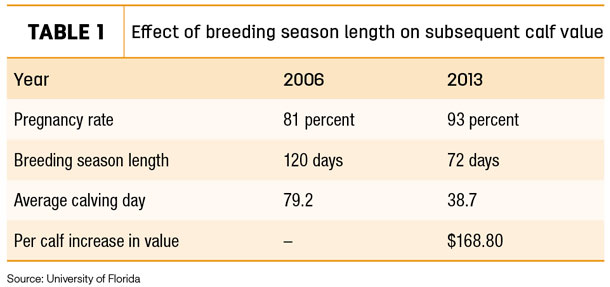Yet unexpected detours and hidden potholes – such as infertility and early embryonic death – can result in a long calving season and uneven-weight calves at the end of the road.
To overcome these barriers, don’t overlook essential fatty acids (EFAs) in your cow and replacement heifer rations. Research shows feeding omega-3 and omega-6 EFAs can tighten the calving window and produce more uniform calves due to improved conception rates and fewer pregnancy losses.
Why calving distribution matters
The calving window has a direct impact on the profitability of your calf crop. When more cows conceive early in the breeding season, more calves hit the ground early in the calving season. Those calves naturally will be larger and heavier at weaning than later-born calves – delivering more salable pounds and more income to your operation.
 Researchers at the University of Florida conducted a seven-year analysis of breeding season length and profitability using fixed-time A.I. By increasing pregnancy rates and shortening the breeding season, the average calving day was 40 days earlier, resulting in more than $168 higher value per calf at weaning. Bull-bred herds can gain similar outcomes by tightening the calving window.
Researchers at the University of Florida conducted a seven-year analysis of breeding season length and profitability using fixed-time A.I. By increasing pregnancy rates and shortening the breeding season, the average calving day was 40 days earlier, resulting in more than $168 higher value per calf at weaning. Bull-bred herds can gain similar outcomes by tightening the calving window.
The lowdown on EFAs
Omega-3 and omega-6 EFAs are critically important to achieve a shorter breeding and calving season. EFAs support many important functions that impact cow health and productivity, including reproduction, the immune system and bone development.
EFAs also provide energy sources during times of body condition loss, such as after calving or when feed sources are limited in late summer or over winter.
There’s a catch: Cattle can’t produce EFAs, so their only source is feed. Animals receive omega-3 and omega-6 EFAs in the ration, then store the EFAs in their bodies until needed for various metabolic functions.
Omega-3 and omega-6 EFAs are found naturally in forages, roasted soybeans, whole cottonseed, flaxseed and other feedstuffs. But providing adequate EFAs is not as simple as just supplementing with these feedstuffs.
That’s because the majority of naturally occurring EFAs are broken down in the rumen and do not reach the small intestine for absorption and utilization by the animal.
The industry now has rumen bypass technologies which solve that issue. But it’s important to know not all bypass technologies are alike. A proven choice is the calcium salt of omega-3 and omega-6 EFAs, which not only bypasses the rumen, it is the only EFA shown in commercial research to improve beef cattle reproduction.
Research proven
Evidence from multiple trials shows feeding bypass omega-3 and omega-6 EFAs has a significant effect on reproductive efficiency in beef cattle. This extensive research includes trials in Oregon, Idaho, Iowa, Texas, Mississippi and Louisiana, as well as overseas.
Here are results from three of the most significant beef studies:
- Research with 1,728 lactating beef cows and first-lactation heifers showed pregnancy rate improved by 11.6 percentage points when animals received EFAs both before and after timed A.I.
- In a Florida on-farm trial with 757 beef heifers, those fed EFAs for 30 days prior to breeding achieved 89 percent pregnancy rate compared with a 70 percent pregnancy rate for those fed a control diet.
- Another study with 771 lactating Angus beef cows showed those fed EFAs for 21 days after breeding had a 60.2 percent pregnancy rate compared with a 51.7 percent pregnancy rate for control cows that didn’t receive EFAs.
How to feed EFAs
EFAs can be incorporated into various management strategies, and there is no need to alter your feeding programs to achieve desired results. Smaller operations often choose products that come in cubes or tubs for easy hand-feeding.
Or EFAs can be incorporated into a complete feed for distribution to the entire herd. Talk to your feed supplier about the best way to incorporate EFAs into your operation.
The generally recommended feeding rate for bypass EFAs is one-quarter to one-third pound per head per day. Feeding from 20 days prior to breeding helps support pregnancy success; continuing to feed for 20 days after breeding helps the cow establish the pregnancy and carry it successfully through gestation.
The feeding protocol is the same whether you are using bull breeding or estrus synchronization programs with timed A.I.
Fed properly, EFAs represent a nominal investment when you consider the potential benefits of gaining significantly more live calves, a tighter calving season and a more uniform calf crop at weaning.
Repro management pays
Remember, EFAs are just one part of a successful reproductive management strategy – supplementation alone cannot ensure reproductive success. Don’t overlook these critical components of your breeding program:
- Maintain a controlled breeding window to avoid late-season, lightweight calves.
- Perform pregnancy exams to assess reproductive success.
- Monitor cow body condition and health throughout breeding and gestation.
- Provide proper nutrition before, during and after breeding time.
- Work with your veterinarian to test fertility of your bulls prior to turnout.
Investment in these management steps, along with feeding bypass omega-6 and omega-3 EFAs in the pre- and post-breeding mineral mix, helps optimize cow fertility and set the stage for reproductive success. The end results: More pregnancies and a healthy, consistent calf crop that returns a profit for your operation. ![]()
PHOTO: The goal when feeding EFAs is to aim for more live calves, a tighter calving window and more uniformity in the calf crop at weaning. Staff photo.
Neil Michael received both DVM and MBA degrees from Purdue University and has over 30 years of industry experience including veterinary practice, dairy management, reproduction and nutritional consulting.
References omitted but are available upon request. Click here to email an editor.

-
Neil Michael
- Manager, Ruminant technical Services
- Arm & Hammer Animal Nutrition
- Email Neil Michael








